Taxation Law Name of the University Authors
VerifiedAdded on 2023/04/23
|12
|2626
|241
AI Summary
Contribute Materials
Your contribution can guide someone’s learning journey. Share your
documents today.
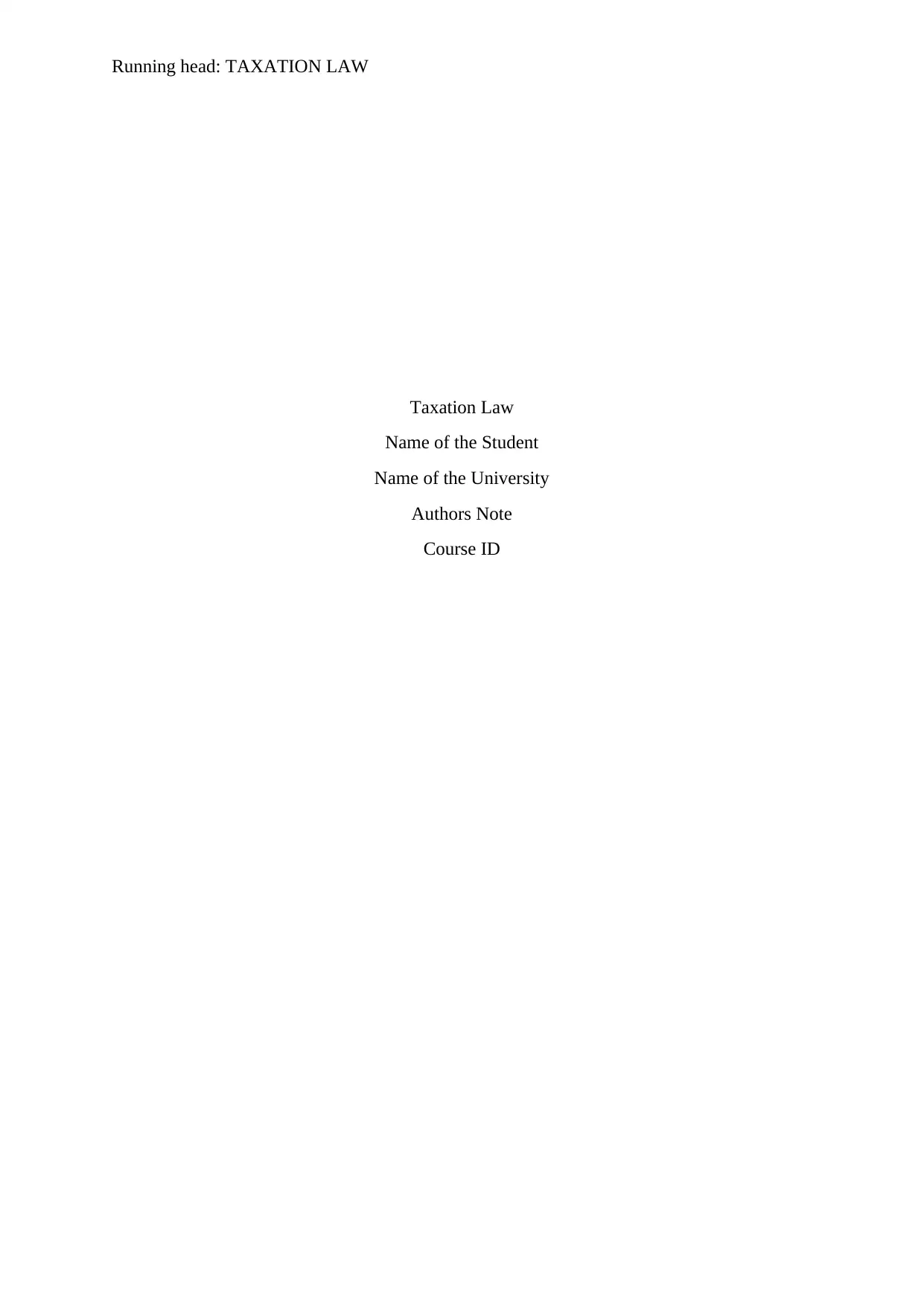
Running head: TAXATION LAW
Taxation Law
Name of the Student
Name of the University
Authors Note
Course ID
Taxation Law
Name of the Student
Name of the University
Authors Note
Course ID
Secure Best Marks with AI Grader
Need help grading? Try our AI Grader for instant feedback on your assignments.
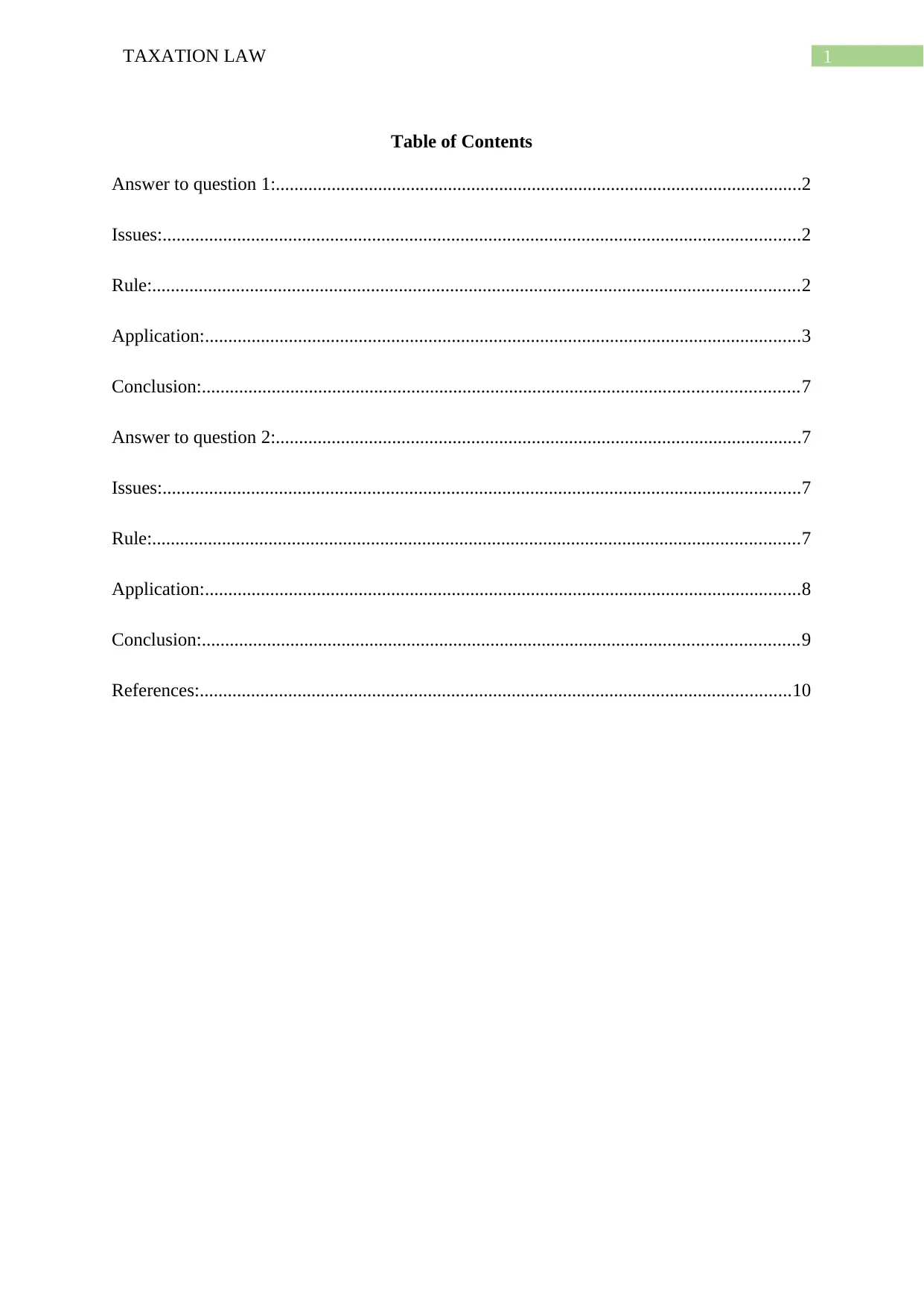
1TAXATION LAW
Table of Contents
Answer to question 1:.................................................................................................................2
Issues:.........................................................................................................................................2
Rule:...........................................................................................................................................2
Application:................................................................................................................................3
Conclusion:................................................................................................................................7
Answer to question 2:.................................................................................................................7
Issues:.........................................................................................................................................7
Rule:...........................................................................................................................................7
Application:................................................................................................................................8
Conclusion:................................................................................................................................9
References:...............................................................................................................................10
Table of Contents
Answer to question 1:.................................................................................................................2
Issues:.........................................................................................................................................2
Rule:...........................................................................................................................................2
Application:................................................................................................................................3
Conclusion:................................................................................................................................7
Answer to question 2:.................................................................................................................7
Issues:.........................................................................................................................................7
Rule:...........................................................................................................................................7
Application:................................................................................................................................8
Conclusion:................................................................................................................................9
References:...............................................................................................................................10
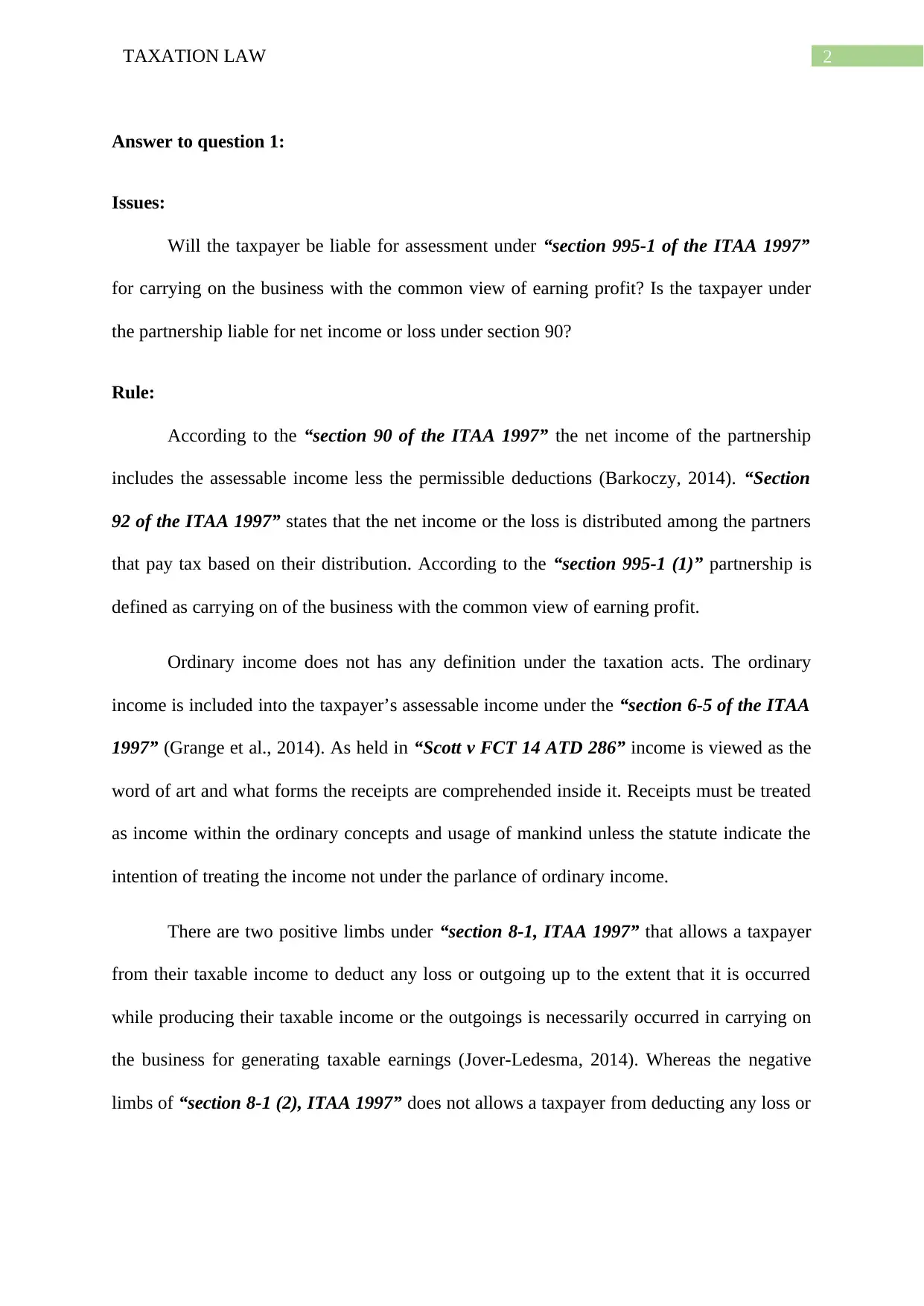
2TAXATION LAW
Answer to question 1:
Issues:
Will the taxpayer be liable for assessment under “section 995-1 of the ITAA 1997”
for carrying on the business with the common view of earning profit? Is the taxpayer under
the partnership liable for net income or loss under section 90?
Rule:
According to the “section 90 of the ITAA 1997” the net income of the partnership
includes the assessable income less the permissible deductions (Barkoczy, 2014). “Section
92 of the ITAA 1997” states that the net income or the loss is distributed among the partners
that pay tax based on their distribution. According to the “section 995-1 (1)” partnership is
defined as carrying on of the business with the common view of earning profit.
Ordinary income does not has any definition under the taxation acts. The ordinary
income is included into the taxpayer’s assessable income under the “section 6-5 of the ITAA
1997” (Grange et al., 2014). As held in “Scott v FCT 14 ATD 286” income is viewed as the
word of art and what forms the receipts are comprehended inside it. Receipts must be treated
as income within the ordinary concepts and usage of mankind unless the statute indicate the
intention of treating the income not under the parlance of ordinary income.
There are two positive limbs under “section 8-1, ITAA 1997” that allows a taxpayer
from their taxable income to deduct any loss or outgoing up to the extent that it is occurred
while producing their taxable income or the outgoings is necessarily occurred in carrying on
the business for generating taxable earnings (Jover-Ledesma, 2014). Whereas the negative
limbs of “section 8-1 (2), ITAA 1997” does not allows a taxpayer from deducting any loss or
Answer to question 1:
Issues:
Will the taxpayer be liable for assessment under “section 995-1 of the ITAA 1997”
for carrying on the business with the common view of earning profit? Is the taxpayer under
the partnership liable for net income or loss under section 90?
Rule:
According to the “section 90 of the ITAA 1997” the net income of the partnership
includes the assessable income less the permissible deductions (Barkoczy, 2014). “Section
92 of the ITAA 1997” states that the net income or the loss is distributed among the partners
that pay tax based on their distribution. According to the “section 995-1 (1)” partnership is
defined as carrying on of the business with the common view of earning profit.
Ordinary income does not has any definition under the taxation acts. The ordinary
income is included into the taxpayer’s assessable income under the “section 6-5 of the ITAA
1997” (Grange et al., 2014). As held in “Scott v FCT 14 ATD 286” income is viewed as the
word of art and what forms the receipts are comprehended inside it. Receipts must be treated
as income within the ordinary concepts and usage of mankind unless the statute indicate the
intention of treating the income not under the parlance of ordinary income.
There are two positive limbs under “section 8-1, ITAA 1997” that allows a taxpayer
from their taxable income to deduct any loss or outgoing up to the extent that it is occurred
while producing their taxable income or the outgoings is necessarily occurred in carrying on
the business for generating taxable earnings (Jover-Ledesma, 2014). Whereas the negative
limbs of “section 8-1 (2), ITAA 1997” does not allows a taxpayer from deducting any loss or
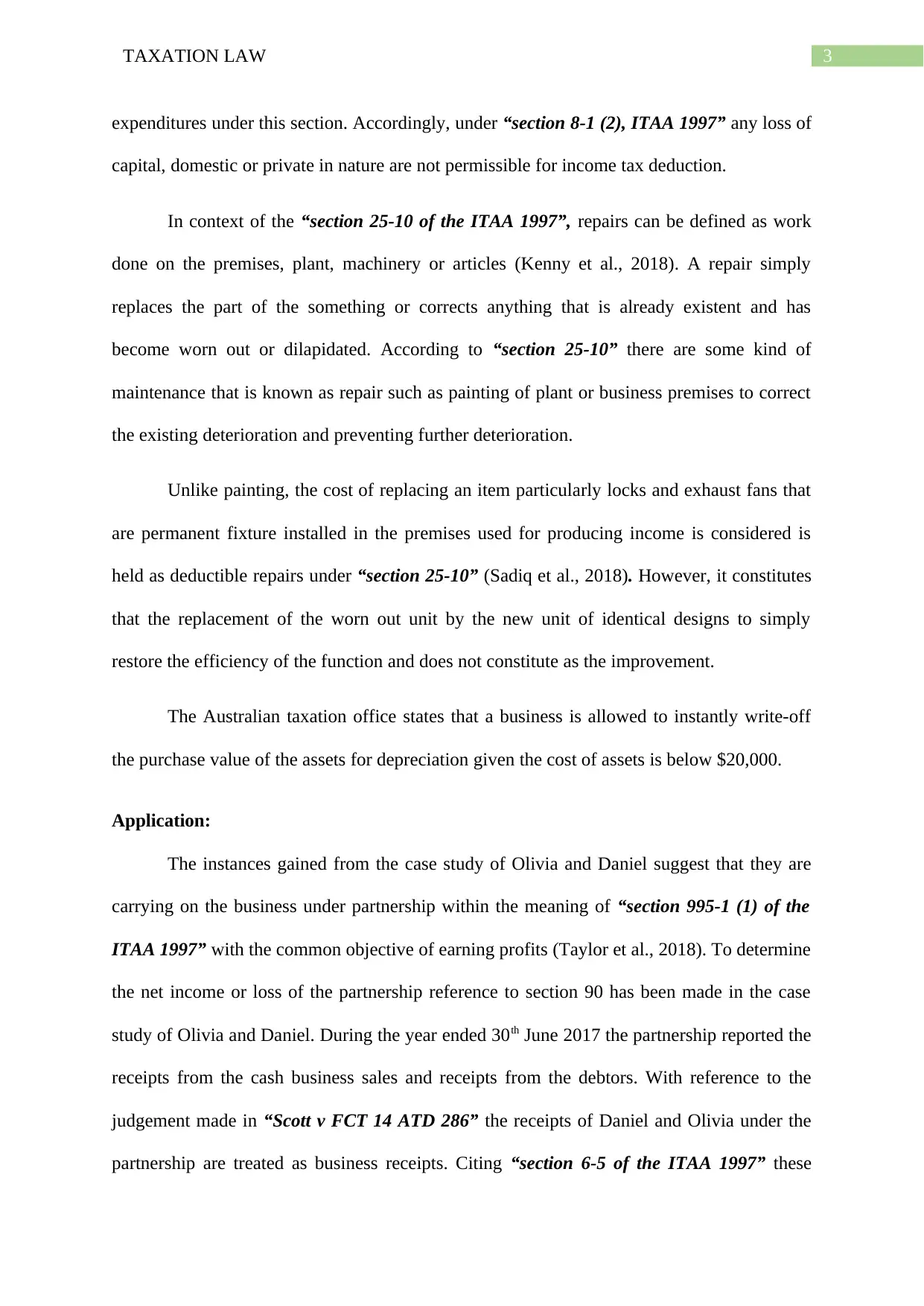
3TAXATION LAW
expenditures under this section. Accordingly, under “section 8-1 (2), ITAA 1997” any loss of
capital, domestic or private in nature are not permissible for income tax deduction.
In context of the “section 25-10 of the ITAA 1997”, repairs can be defined as work
done on the premises, plant, machinery or articles (Kenny et al., 2018). A repair simply
replaces the part of the something or corrects anything that is already existent and has
become worn out or dilapidated. According to “section 25-10” there are some kind of
maintenance that is known as repair such as painting of plant or business premises to correct
the existing deterioration and preventing further deterioration.
Unlike painting, the cost of replacing an item particularly locks and exhaust fans that
are permanent fixture installed in the premises used for producing income is considered is
held as deductible repairs under “section 25-10” (Sadiq et al., 2018). However, it constitutes
that the replacement of the worn out unit by the new unit of identical designs to simply
restore the efficiency of the function and does not constitute as the improvement.
The Australian taxation office states that a business is allowed to instantly write-off
the purchase value of the assets for depreciation given the cost of assets is below $20,000.
Application:
The instances gained from the case study of Olivia and Daniel suggest that they are
carrying on the business under partnership within the meaning of “section 995-1 (1) of the
ITAA 1997” with the common objective of earning profits (Taylor et al., 2018). To determine
the net income or loss of the partnership reference to section 90 has been made in the case
study of Olivia and Daniel. During the year ended 30th June 2017 the partnership reported the
receipts from the cash business sales and receipts from the debtors. With reference to the
judgement made in “Scott v FCT 14 ATD 286” the receipts of Daniel and Olivia under the
partnership are treated as business receipts. Citing “section 6-5 of the ITAA 1997” these
expenditures under this section. Accordingly, under “section 8-1 (2), ITAA 1997” any loss of
capital, domestic or private in nature are not permissible for income tax deduction.
In context of the “section 25-10 of the ITAA 1997”, repairs can be defined as work
done on the premises, plant, machinery or articles (Kenny et al., 2018). A repair simply
replaces the part of the something or corrects anything that is already existent and has
become worn out or dilapidated. According to “section 25-10” there are some kind of
maintenance that is known as repair such as painting of plant or business premises to correct
the existing deterioration and preventing further deterioration.
Unlike painting, the cost of replacing an item particularly locks and exhaust fans that
are permanent fixture installed in the premises used for producing income is considered is
held as deductible repairs under “section 25-10” (Sadiq et al., 2018). However, it constitutes
that the replacement of the worn out unit by the new unit of identical designs to simply
restore the efficiency of the function and does not constitute as the improvement.
The Australian taxation office states that a business is allowed to instantly write-off
the purchase value of the assets for depreciation given the cost of assets is below $20,000.
Application:
The instances gained from the case study of Olivia and Daniel suggest that they are
carrying on the business under partnership within the meaning of “section 995-1 (1) of the
ITAA 1997” with the common objective of earning profits (Taylor et al., 2018). To determine
the net income or loss of the partnership reference to section 90 has been made in the case
study of Olivia and Daniel. During the year ended 30th June 2017 the partnership reported the
receipts from the cash business sales and receipts from the debtors. With reference to the
judgement made in “Scott v FCT 14 ATD 286” the receipts of Daniel and Olivia under the
partnership are treated as business receipts. Citing “section 6-5 of the ITAA 1997” these
Secure Best Marks with AI Grader
Need help grading? Try our AI Grader for instant feedback on your assignments.
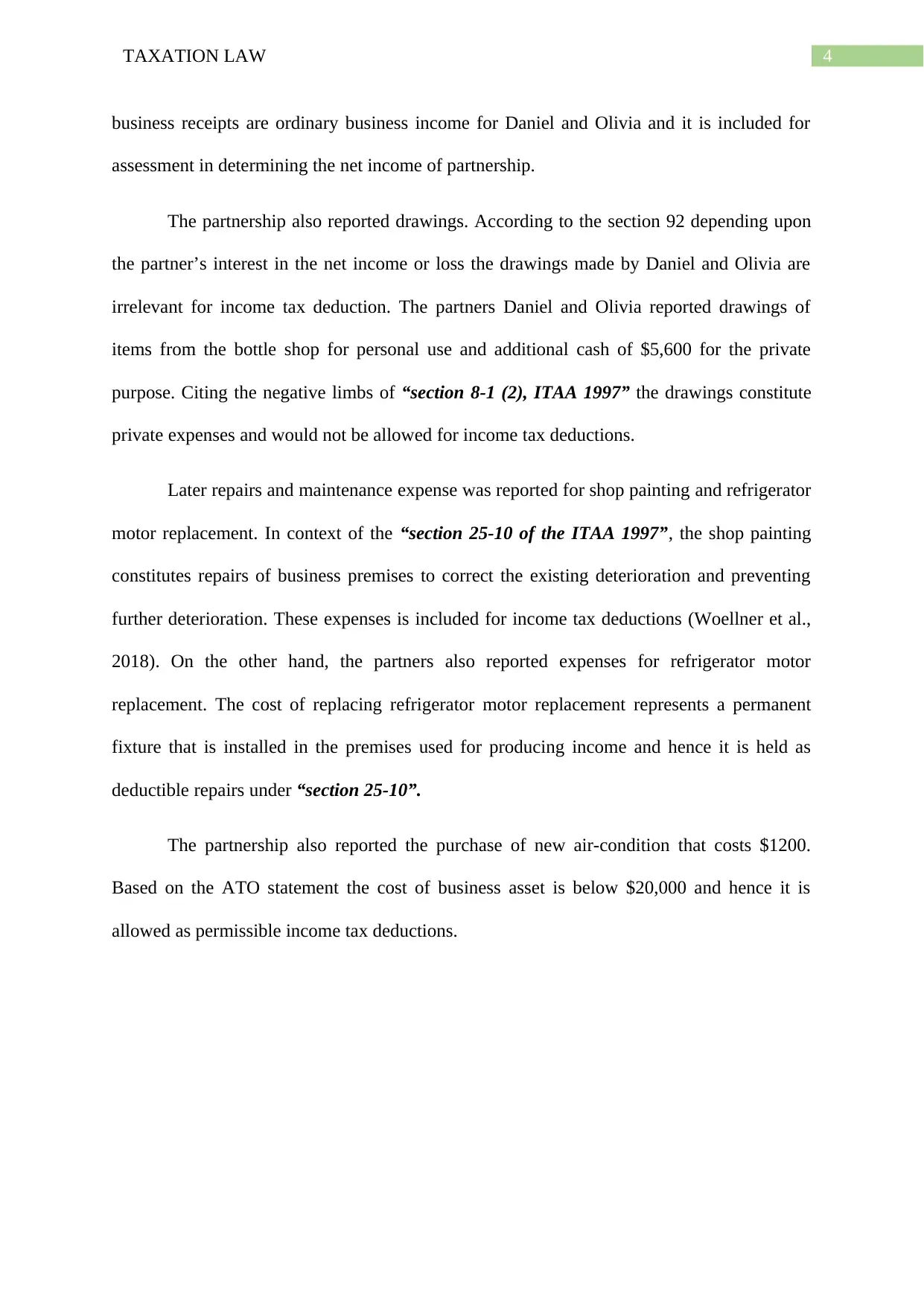
4TAXATION LAW
business receipts are ordinary business income for Daniel and Olivia and it is included for
assessment in determining the net income of partnership.
The partnership also reported drawings. According to the section 92 depending upon
the partner’s interest in the net income or loss the drawings made by Daniel and Olivia are
irrelevant for income tax deduction. The partners Daniel and Olivia reported drawings of
items from the bottle shop for personal use and additional cash of $5,600 for the private
purpose. Citing the negative limbs of “section 8-1 (2), ITAA 1997” the drawings constitute
private expenses and would not be allowed for income tax deductions.
Later repairs and maintenance expense was reported for shop painting and refrigerator
motor replacement. In context of the “section 25-10 of the ITAA 1997”, the shop painting
constitutes repairs of business premises to correct the existing deterioration and preventing
further deterioration. These expenses is included for income tax deductions (Woellner et al.,
2018). On the other hand, the partners also reported expenses for refrigerator motor
replacement. The cost of replacing refrigerator motor replacement represents a permanent
fixture that is installed in the premises used for producing income and hence it is held as
deductible repairs under “section 25-10”.
The partnership also reported the purchase of new air-condition that costs $1200.
Based on the ATO statement the cost of business asset is below $20,000 and hence it is
allowed as permissible income tax deductions.
business receipts are ordinary business income for Daniel and Olivia and it is included for
assessment in determining the net income of partnership.
The partnership also reported drawings. According to the section 92 depending upon
the partner’s interest in the net income or loss the drawings made by Daniel and Olivia are
irrelevant for income tax deduction. The partners Daniel and Olivia reported drawings of
items from the bottle shop for personal use and additional cash of $5,600 for the private
purpose. Citing the negative limbs of “section 8-1 (2), ITAA 1997” the drawings constitute
private expenses and would not be allowed for income tax deductions.
Later repairs and maintenance expense was reported for shop painting and refrigerator
motor replacement. In context of the “section 25-10 of the ITAA 1997”, the shop painting
constitutes repairs of business premises to correct the existing deterioration and preventing
further deterioration. These expenses is included for income tax deductions (Woellner et al.,
2018). On the other hand, the partners also reported expenses for refrigerator motor
replacement. The cost of replacing refrigerator motor replacement represents a permanent
fixture that is installed in the premises used for producing income and hence it is held as
deductible repairs under “section 25-10”.
The partnership also reported the purchase of new air-condition that costs $1200.
Based on the ATO statement the cost of business asset is below $20,000 and hence it is
allowed as permissible income tax deductions.

5TAXATION LAW
Particulars Amount ($)
Receipts
Business sales 1,50,170.00$
Debtors Cash payments (Notes 1) 33,715.00$
Total Receipts 1,83,885.00$
Expenses Eligble for Deductions
Electricity Bill 1,176.00$
Council rates (Notes 6) 310.20$
Business Insurance 1,250.00$
Mobile Bills (Notes 6) 633.60$
Union Bills 284.00$
Account Charges 595.00$
Repair Expenses (Notes 7) 1,780.00$
Loan Expenses (Notes 4) 5,500.00$
Purchase of Fixed Asset 3,500.00$
Cost of Sales (Notes 3) 30,525.00$
Van (Notes 5) 1,134.00$
SUV (Notes 5) 1,230.00$
Repayment to Creditors (Notes 2) 1,28,168.00$
Installation of Air-Condition 1,200.00$
Depreciation Expenses(Notes 8) 726.20$
New Restaurant Freezer 3,500.00$
Total Expenses Eligible for Deductions 1,81,512.00$
Net Income From Partnership 2,373.00$
Computation of Partnership Net Income
For the year ended 30th June 2017
Working Papers:
Depreciation Schedule Base Value Total Days Held Depreciation
New Restaurant Freezer 3,500.00$
Less: Trade In Value @ 500 3,000.00$ 333.00$ 547.40$
Air Conditions installation 1,200.00$ 272.00$ 178.85$
Total Depreciation 726.25$
Working papers
Notes 8
Particulars Amount ($)
Receipts
Business sales 1,50,170.00$
Debtors Cash payments (Notes 1) 33,715.00$
Total Receipts 1,83,885.00$
Expenses Eligble for Deductions
Electricity Bill 1,176.00$
Council rates (Notes 6) 310.20$
Business Insurance 1,250.00$
Mobile Bills (Notes 6) 633.60$
Union Bills 284.00$
Account Charges 595.00$
Repair Expenses (Notes 7) 1,780.00$
Loan Expenses (Notes 4) 5,500.00$
Purchase of Fixed Asset 3,500.00$
Cost of Sales (Notes 3) 30,525.00$
Van (Notes 5) 1,134.00$
SUV (Notes 5) 1,230.00$
Repayment to Creditors (Notes 2) 1,28,168.00$
Installation of Air-Condition 1,200.00$
Depreciation Expenses(Notes 8) 726.20$
New Restaurant Freezer 3,500.00$
Total Expenses Eligible for Deductions 1,81,512.00$
Net Income From Partnership 2,373.00$
Computation of Partnership Net Income
For the year ended 30th June 2017
Working Papers:
Depreciation Schedule Base Value Total Days Held Depreciation
New Restaurant Freezer 3,500.00$
Less: Trade In Value @ 500 3,000.00$ 333.00$ 547.40$
Air Conditions installation 1,200.00$ 272.00$ 178.85$
Total Depreciation 726.25$
Working papers
Notes 8
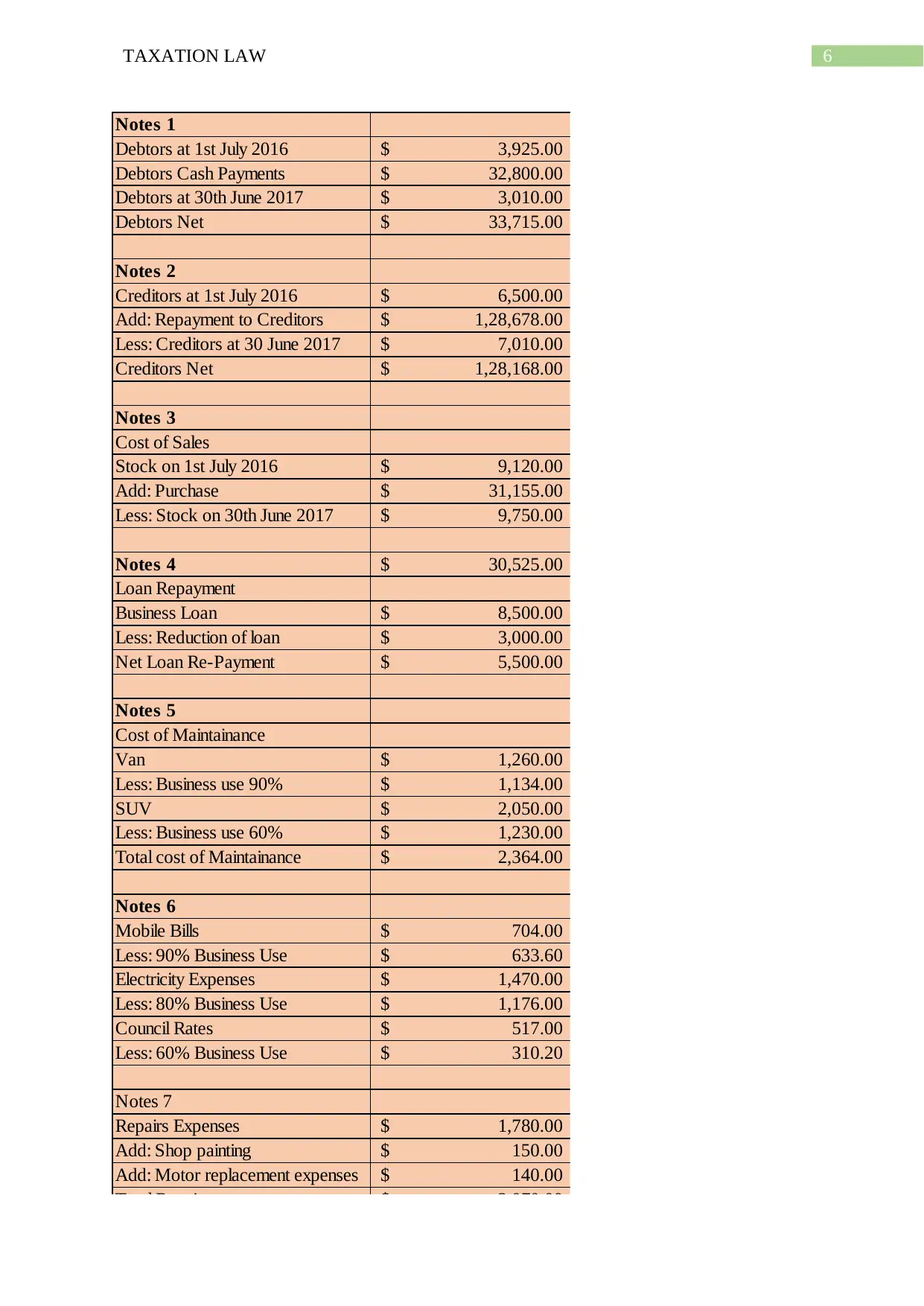
6TAXATION LAW
Notes 1
Debtors at 1st July 2016 3,925.00$
Debtors Cash Payments 32,800.00$
Debtors at 30th June 2017 3,010.00$
Debtors Net 33,715.00$
Notes 2
Creditors at 1st July 2016 6,500.00$
Add: Repayment to Creditors 1,28,678.00$
Less: Creditors at 30 June 2017 7,010.00$
Creditors Net 1,28,168.00$
Notes 3
Cost of Sales
Stock on 1st July 2016 9,120.00$
Add: Purchase 31,155.00$
Less: Stock on 30th June 2017 9,750.00$
Notes 4 30,525.00$
Loan Repayment
Business Loan 8,500.00$
Less: Reduction of loan 3,000.00$
Net Loan Re-Payment 5,500.00$
Notes 5
Cost of Maintainance
Van 1,260.00$
Less: Business use 90% 1,134.00$
SUV 2,050.00$
Less: Business use 60% 1,230.00$
Total cost of Maintainance 2,364.00$
Notes 6
Mobile Bills 704.00$
Less: 90% Business Use 633.60$
Electricity Expenses 1,470.00$
Less: 80% Business Use 1,176.00$
Council Rates 517.00$
Less: 60% Business Use 310.20$
Notes 7
Repairs Expenses 1,780.00$
Add: Shop painting 150.00$
Add: Motor replacement expenses 140.00$
Total Repairs 2,070.00$
Notes 1
Debtors at 1st July 2016 3,925.00$
Debtors Cash Payments 32,800.00$
Debtors at 30th June 2017 3,010.00$
Debtors Net 33,715.00$
Notes 2
Creditors at 1st July 2016 6,500.00$
Add: Repayment to Creditors 1,28,678.00$
Less: Creditors at 30 June 2017 7,010.00$
Creditors Net 1,28,168.00$
Notes 3
Cost of Sales
Stock on 1st July 2016 9,120.00$
Add: Purchase 31,155.00$
Less: Stock on 30th June 2017 9,750.00$
Notes 4 30,525.00$
Loan Repayment
Business Loan 8,500.00$
Less: Reduction of loan 3,000.00$
Net Loan Re-Payment 5,500.00$
Notes 5
Cost of Maintainance
Van 1,260.00$
Less: Business use 90% 1,134.00$
SUV 2,050.00$
Less: Business use 60% 1,230.00$
Total cost of Maintainance 2,364.00$
Notes 6
Mobile Bills 704.00$
Less: 90% Business Use 633.60$
Electricity Expenses 1,470.00$
Less: 80% Business Use 1,176.00$
Council Rates 517.00$
Less: 60% Business Use 310.20$
Notes 7
Repairs Expenses 1,780.00$
Add: Shop painting 150.00$
Add: Motor replacement expenses 140.00$
Total Repairs 2,070.00$
Paraphrase This Document
Need a fresh take? Get an instant paraphrase of this document with our AI Paraphraser

7TAXATION LAW
Conclusion:
On a conclusive note, under section 90 the net income of partners following the
deductions stood $2,373 for the year ended 30th June 2017.
Answer to question 2:
Issues:
The current issue is based on determining the amount of fringe benefit tax payable by
the employer in respect of the fringe benefit provided to the employee under the legislation of
“FBTAA 1986”.
Rule:
Fringe benefit is referred as the payment that is made to the employee however, it is
recognized diverse from the salary or wages. As defined under the fringe benefit tax
legislation, a fringe benefit is regarded as the benefit that is provided by the employer to the
member of the staff in relation to their employment (Austlii.edu.au, 2019). The fringe benefit
tax is paid by the employer, if the employer makes the payment to the employee, company
director or the office holder that is subjected to the obligation of withholding. However, the
employer here can claim a deduction on the income tax relating to the cost of providing
fringe benefit and relating to the amount of fringe benefit tax the employer pays.
“Section 20 of the FBTAA 1986” is related to the expense payment fringe benefit.
“Under section 20”, where the provider of benefit makes any payment either whole or in part
as the obligation of another person to pay the amount to the third party in relation the
expenses incurred by the recipient constitute expense payment fringe benefit (Wilson et al.,
2015). The taxable value of the expenditure payment fringe benefit for employer is the
amount that they reimburse of pay.
Conclusion:
On a conclusive note, under section 90 the net income of partners following the
deductions stood $2,373 for the year ended 30th June 2017.
Answer to question 2:
Issues:
The current issue is based on determining the amount of fringe benefit tax payable by
the employer in respect of the fringe benefit provided to the employee under the legislation of
“FBTAA 1986”.
Rule:
Fringe benefit is referred as the payment that is made to the employee however, it is
recognized diverse from the salary or wages. As defined under the fringe benefit tax
legislation, a fringe benefit is regarded as the benefit that is provided by the employer to the
member of the staff in relation to their employment (Austlii.edu.au, 2019). The fringe benefit
tax is paid by the employer, if the employer makes the payment to the employee, company
director or the office holder that is subjected to the obligation of withholding. However, the
employer here can claim a deduction on the income tax relating to the cost of providing
fringe benefit and relating to the amount of fringe benefit tax the employer pays.
“Section 20 of the FBTAA 1986” is related to the expense payment fringe benefit.
“Under section 20”, where the provider of benefit makes any payment either whole or in part
as the obligation of another person to pay the amount to the third party in relation the
expenses incurred by the recipient constitute expense payment fringe benefit (Wilson et al.,
2015). The taxable value of the expenditure payment fringe benefit for employer is the
amount that they reimburse of pay.
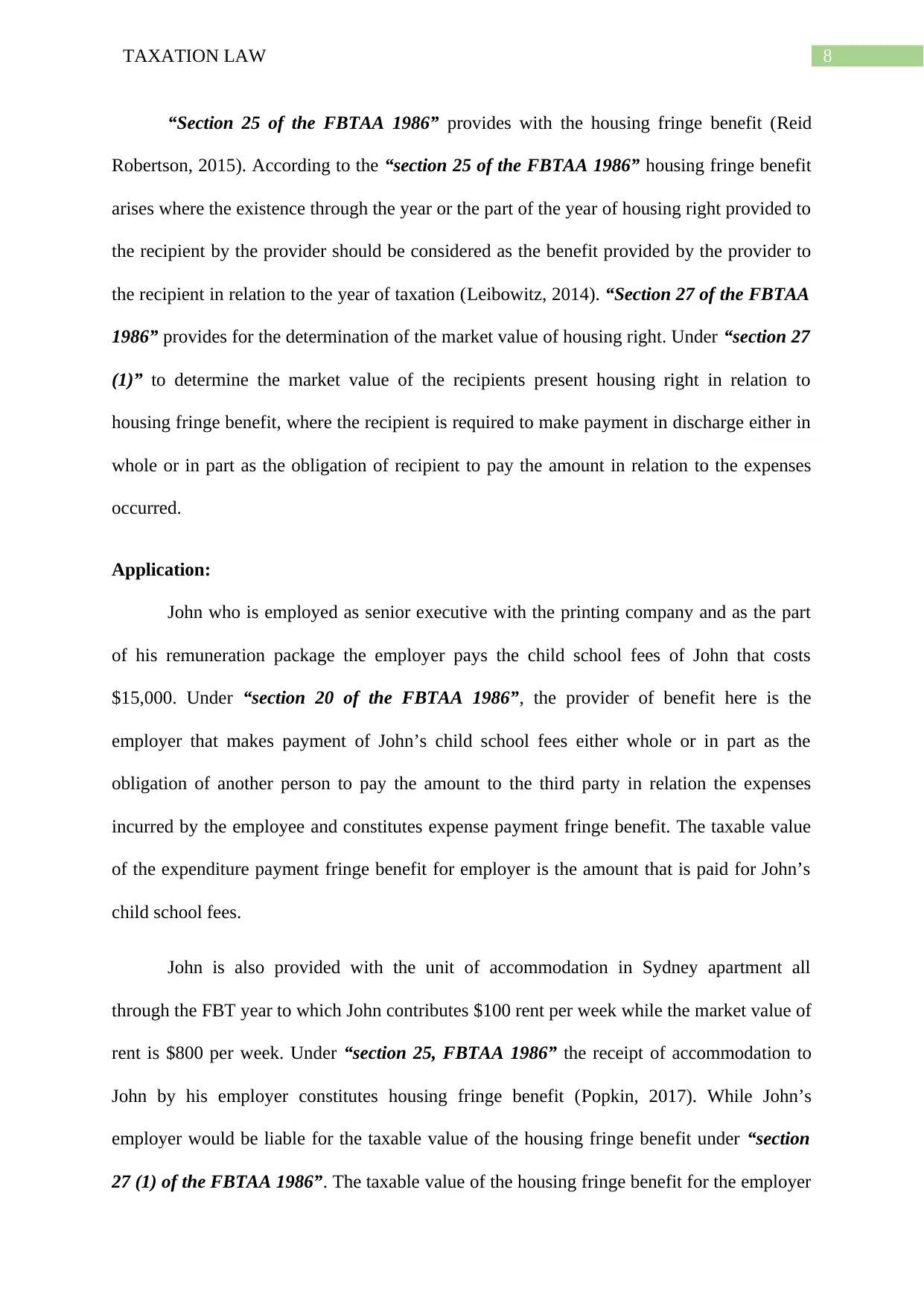
8TAXATION LAW
“Section 25 of the FBTAA 1986” provides with the housing fringe benefit (Reid
Robertson, 2015). According to the “section 25 of the FBTAA 1986” housing fringe benefit
arises where the existence through the year or the part of the year of housing right provided to
the recipient by the provider should be considered as the benefit provided by the provider to
the recipient in relation to the year of taxation (Leibowitz, 2014). “Section 27 of the FBTAA
1986” provides for the determination of the market value of housing right. Under “section 27
(1)” to determine the market value of the recipients present housing right in relation to
housing fringe benefit, where the recipient is required to make payment in discharge either in
whole or in part as the obligation of recipient to pay the amount in relation to the expenses
occurred.
Application:
John who is employed as senior executive with the printing company and as the part
of his remuneration package the employer pays the child school fees of John that costs
$15,000. Under “section 20 of the FBTAA 1986”, the provider of benefit here is the
employer that makes payment of John’s child school fees either whole or in part as the
obligation of another person to pay the amount to the third party in relation the expenses
incurred by the employee and constitutes expense payment fringe benefit. The taxable value
of the expenditure payment fringe benefit for employer is the amount that is paid for John’s
child school fees.
John is also provided with the unit of accommodation in Sydney apartment all
through the FBT year to which John contributes $100 rent per week while the market value of
rent is $800 per week. Under “section 25, FBTAA 1986” the receipt of accommodation to
John by his employer constitutes housing fringe benefit (Popkin, 2017). While John’s
employer would be liable for the taxable value of the housing fringe benefit under “section
27 (1) of the FBTAA 1986”. The taxable value of the housing fringe benefit for the employer
“Section 25 of the FBTAA 1986” provides with the housing fringe benefit (Reid
Robertson, 2015). According to the “section 25 of the FBTAA 1986” housing fringe benefit
arises where the existence through the year or the part of the year of housing right provided to
the recipient by the provider should be considered as the benefit provided by the provider to
the recipient in relation to the year of taxation (Leibowitz, 2014). “Section 27 of the FBTAA
1986” provides for the determination of the market value of housing right. Under “section 27
(1)” to determine the market value of the recipients present housing right in relation to
housing fringe benefit, where the recipient is required to make payment in discharge either in
whole or in part as the obligation of recipient to pay the amount in relation to the expenses
occurred.
Application:
John who is employed as senior executive with the printing company and as the part
of his remuneration package the employer pays the child school fees of John that costs
$15,000. Under “section 20 of the FBTAA 1986”, the provider of benefit here is the
employer that makes payment of John’s child school fees either whole or in part as the
obligation of another person to pay the amount to the third party in relation the expenses
incurred by the employee and constitutes expense payment fringe benefit. The taxable value
of the expenditure payment fringe benefit for employer is the amount that is paid for John’s
child school fees.
John is also provided with the unit of accommodation in Sydney apartment all
through the FBT year to which John contributes $100 rent per week while the market value of
rent is $800 per week. Under “section 25, FBTAA 1986” the receipt of accommodation to
John by his employer constitutes housing fringe benefit (Popkin, 2017). While John’s
employer would be liable for the taxable value of the housing fringe benefit under “section
27 (1) of the FBTAA 1986”. The taxable value of the housing fringe benefit for the employer
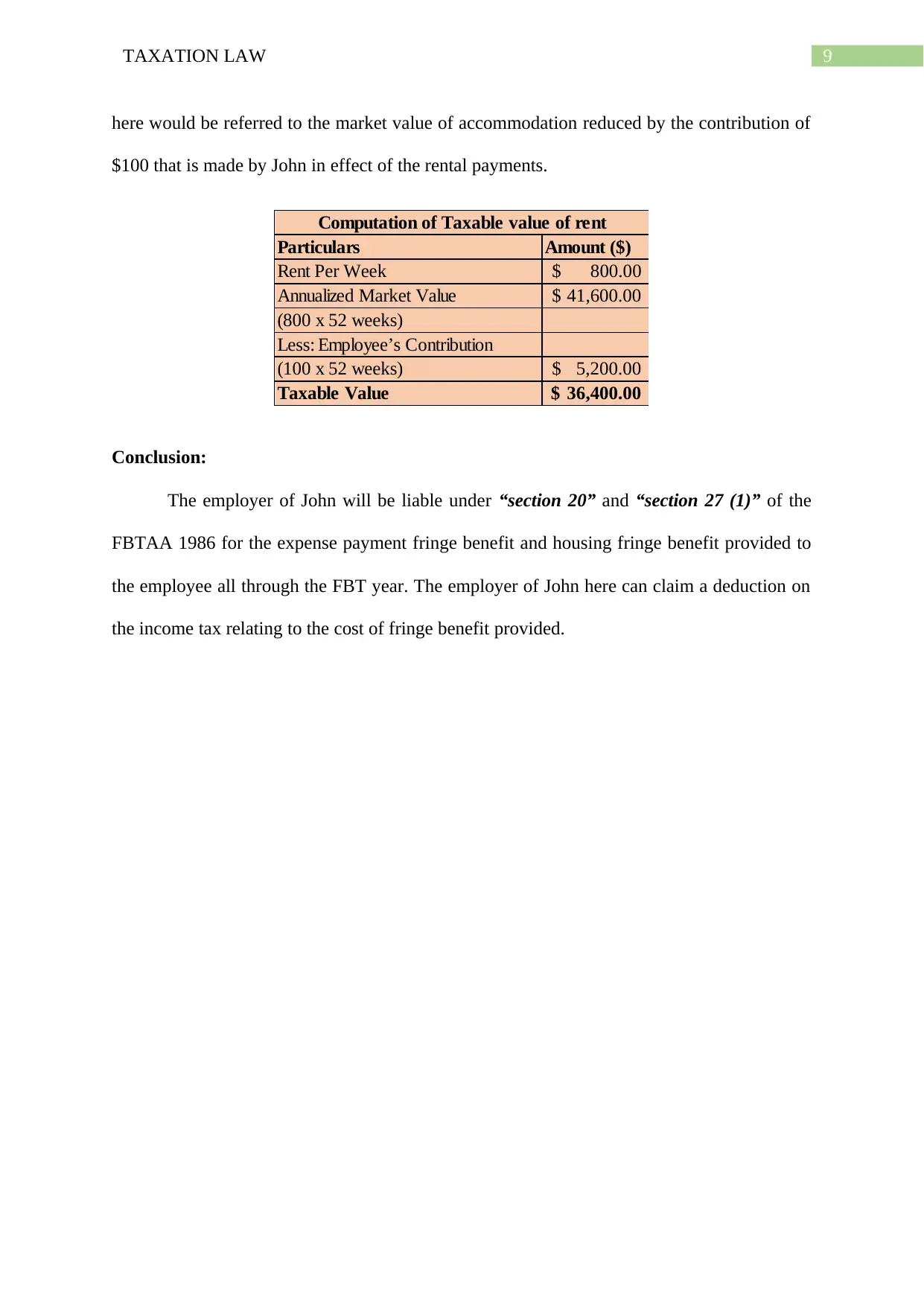
9TAXATION LAW
here would be referred to the market value of accommodation reduced by the contribution of
$100 that is made by John in effect of the rental payments.
Particulars Amount ($)
Rent Per Week 800.00$
Annualized Market Value 41,600.00$
(800 x 52 weeks)
Less: Employee’s Contribution
(100 x 52 weeks) 5,200.00$
Taxable Value 36,400.00$
Computation of Taxable value of rent
Conclusion:
The employer of John will be liable under “section 20” and “section 27 (1)” of the
FBTAA 1986 for the expense payment fringe benefit and housing fringe benefit provided to
the employee all through the FBT year. The employer of John here can claim a deduction on
the income tax relating to the cost of fringe benefit provided.
here would be referred to the market value of accommodation reduced by the contribution of
$100 that is made by John in effect of the rental payments.
Particulars Amount ($)
Rent Per Week 800.00$
Annualized Market Value 41,600.00$
(800 x 52 weeks)
Less: Employee’s Contribution
(100 x 52 weeks) 5,200.00$
Taxable Value 36,400.00$
Computation of Taxable value of rent
Conclusion:
The employer of John will be liable under “section 20” and “section 27 (1)” of the
FBTAA 1986 for the expense payment fringe benefit and housing fringe benefit provided to
the employee all through the FBT year. The employer of John here can claim a deduction on
the income tax relating to the cost of fringe benefit provided.
Secure Best Marks with AI Grader
Need help grading? Try our AI Grader for instant feedback on your assignments.
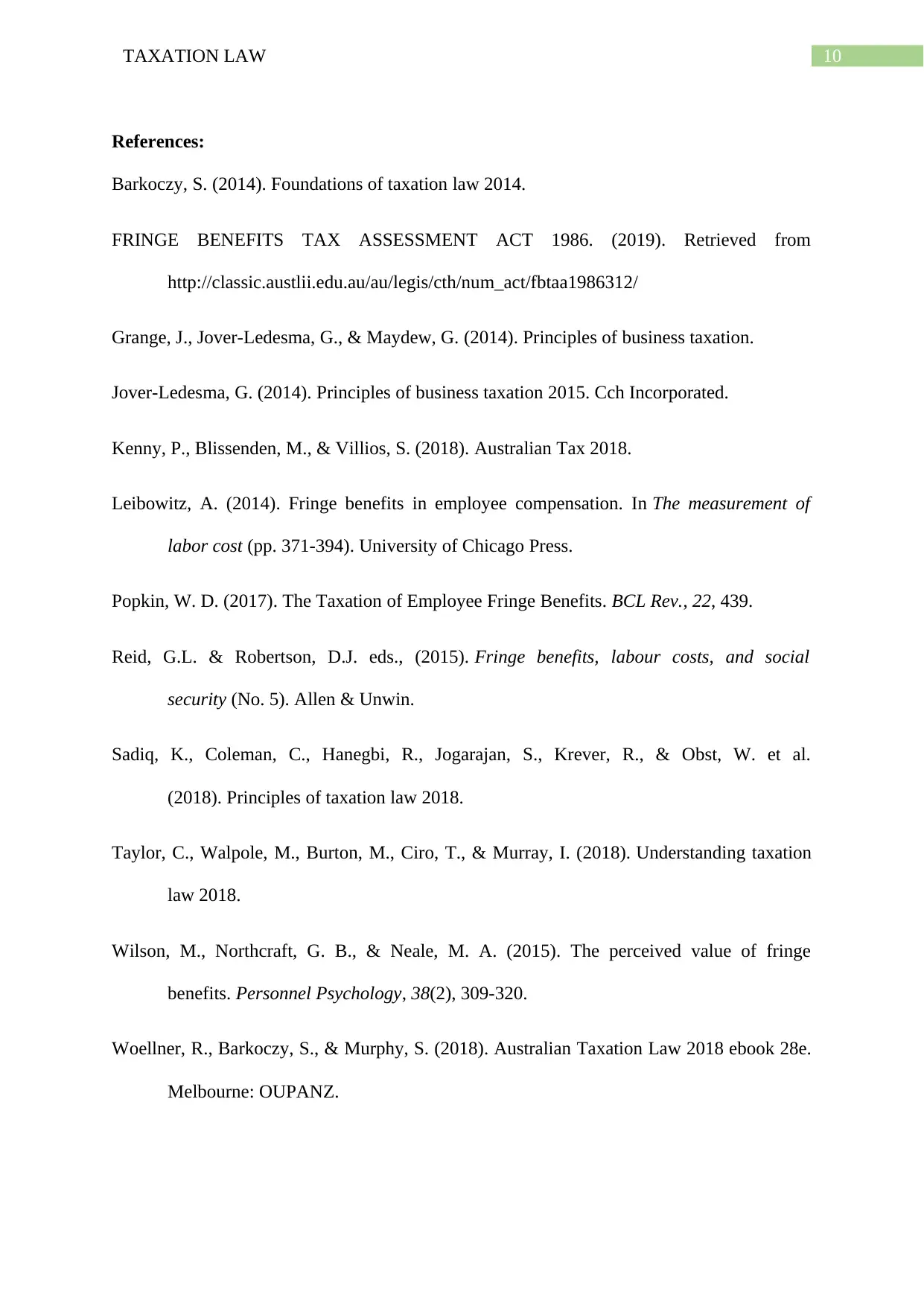
10TAXATION LAW
References:
Barkoczy, S. (2014). Foundations of taxation law 2014.
FRINGE BENEFITS TAX ASSESSMENT ACT 1986. (2019). Retrieved from
http://classic.austlii.edu.au/au/legis/cth/num_act/fbtaa1986312/
Grange, J., Jover-Ledesma, G., & Maydew, G. (2014). Principles of business taxation.
Jover-Ledesma, G. (2014). Principles of business taxation 2015. Cch Incorporated.
Kenny, P., Blissenden, M., & Villios, S. (2018). Australian Tax 2018.
Leibowitz, A. (2014). Fringe benefits in employee compensation. In The measurement of
labor cost (pp. 371-394). University of Chicago Press.
Popkin, W. D. (2017). The Taxation of Employee Fringe Benefits. BCL Rev., 22, 439.
Reid, G.L. & Robertson, D.J. eds., (2015). Fringe benefits, labour costs, and social
security (No. 5). Allen & Unwin.
Sadiq, K., Coleman, C., Hanegbi, R., Jogarajan, S., Krever, R., & Obst, W. et al.
(2018). Principles of taxation law 2018.
Taylor, C., Walpole, M., Burton, M., Ciro, T., & Murray, I. (2018). Understanding taxation
law 2018.
Wilson, M., Northcraft, G. B., & Neale, M. A. (2015). The perceived value of fringe
benefits. Personnel Psychology, 38(2), 309-320.
Woellner, R., Barkoczy, S., & Murphy, S. (2018). Australian Taxation Law 2018 ebook 28e.
Melbourne: OUPANZ.
References:
Barkoczy, S. (2014). Foundations of taxation law 2014.
FRINGE BENEFITS TAX ASSESSMENT ACT 1986. (2019). Retrieved from
http://classic.austlii.edu.au/au/legis/cth/num_act/fbtaa1986312/
Grange, J., Jover-Ledesma, G., & Maydew, G. (2014). Principles of business taxation.
Jover-Ledesma, G. (2014). Principles of business taxation 2015. Cch Incorporated.
Kenny, P., Blissenden, M., & Villios, S. (2018). Australian Tax 2018.
Leibowitz, A. (2014). Fringe benefits in employee compensation. In The measurement of
labor cost (pp. 371-394). University of Chicago Press.
Popkin, W. D. (2017). The Taxation of Employee Fringe Benefits. BCL Rev., 22, 439.
Reid, G.L. & Robertson, D.J. eds., (2015). Fringe benefits, labour costs, and social
security (No. 5). Allen & Unwin.
Sadiq, K., Coleman, C., Hanegbi, R., Jogarajan, S., Krever, R., & Obst, W. et al.
(2018). Principles of taxation law 2018.
Taylor, C., Walpole, M., Burton, M., Ciro, T., & Murray, I. (2018). Understanding taxation
law 2018.
Wilson, M., Northcraft, G. B., & Neale, M. A. (2015). The perceived value of fringe
benefits. Personnel Psychology, 38(2), 309-320.
Woellner, R., Barkoczy, S., & Murphy, S. (2018). Australian Taxation Law 2018 ebook 28e.
Melbourne: OUPANZ.

11TAXATION LAW
1 out of 12
Related Documents
Your All-in-One AI-Powered Toolkit for Academic Success.
+13062052269
info@desklib.com
Available 24*7 on WhatsApp / Email
![[object Object]](/_next/static/media/star-bottom.7253800d.svg)
Unlock your academic potential
© 2024 | Zucol Services PVT LTD | All rights reserved.





